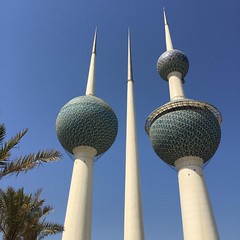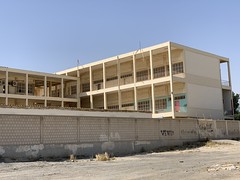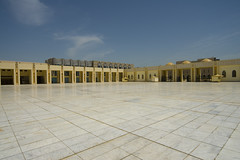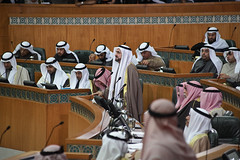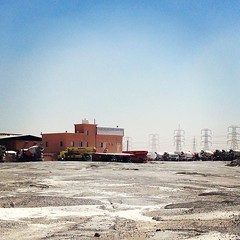 Kuwait
Kuwait
Kuwait (English: /kʊˈwt/; Arabic: الكويت , or), officially the State of Kuwait (Arabic: دولة الكويت Dawlat al-Kuwayt), is a country in Western Asia. It is situated in the northern edge of Eastern Arabia at the tip of the Persian Gulf, bordering Iraq to the north and Saudi Arabia to the south. Kuwait also shares maritime borders with Iran. Kuwait has a coastal length of approximately . Most of the country's population reside in the urban agglomeration of the capital city Kuwait City. , Kuwait has a population of 4.45 million people of which 1.45 million are Kuwaiti citizens while the remaining 3.00 million are foreign nationals from over 100 countries. Kuwait has the largest number of stateless people in the entire region.
Historically, most of present-day Kuwait was part of ancient Mesopotamia. Pre-oil Kuwait was a strategic trade port between Mesopotamia, Persia and India. Oil reserves were discovered in commercial quantities in 1938. In 1946, crude oil was exported for the first time. From 1946 to 1982, the country underwent large-scale modernization, largely based on income from oil production. In the 1980s, Kuwait experienced a period of geopolitical instability and an economic crisis following the stock market crash. In 1990, after oil production disputes with neighbouring Iraq, Kuwait was invaded, and later annexed into one of Iraq's governorates by Iraq under Saddam Hussein. The Iraqi occupation of Kuwait came to an end on February 26, 1991, after military intervention by a military coalition led by the United States and various other countries.
As an Arab state in the Persian Gulf, Kuwait is an emirate. The emir is the head of state and the Al Sabah is the ruling family which dominates the country's political system. Kuwait's official state religion is Islam. Kuwait is a developing country with a high-income economy, backed by the world's sixth largest oil reserves. The Kuwaiti dinar is the highest valued currency in the world. Kuwaiti popular culture, in the form of theatre, radio, music, and television soap opera, is regionally influential and exported to neighboring GCC states. In 2009, Kuwait had the highest Human Development Index in the Arab world. Kuwait is a founding member of the GCC and is also a member of the UN, AL, OPEC and the OIC. In July 2022, Kuwait named the emir's son as the country's new prime minister to replace caretaker premier Sheikh Sabah al-Khalid, who faced a combative parliament as head of cabinet in a feud hindering fiscal reform.
Etymology
The country's name is from the Arabic diminutive form of (or), meaning "fortress built near water". Since 1961, the official name of the state is the "State of Kuwait".
History
Antiquity
Following the post-glacial flooding of the Persian Gulf basin, debris from the Tigris–Euphrates river formed a substantial delta, creating most of the land in present-day Kuwait and establishing the present coastlines. One of the earliest evidence of human habitation in Kuwait dates back to 8000 BC where Mesolithic tools were found in Burgan. Historically, most of present-day Kuwait was part of ancient Mesopotamia.
During the Ubaid period (6500 BC), Kuwait was the central site of interaction between the peoples of Mesopotamia and Neolithic Eastern Arabia, including Bahra 1 and site H3 in Subiya. The Neolithic inhabitants of Kuwait were among the world's earliest maritime traders. One of the world's earliest reed-boats was discovered at site H3 dating back to the Ubaid period. Other Neolithic sites in Kuwait are located in Khiran and Sulaibikhat.
Mesopotamians first settled in the Kuwaiti island of Failaka in 2000 B.C. Traders from the Sumerian city of Ur inhabited Failaka and ran a mercantile business. The island had many Mesopotamian-style buildings typical of those found in Iraq dating from around 2000 B.C. In 4000 BC until 2000 BC, Kuwait was home to the Dilmun civilization. Dilmun included Al-Shadadiya, Akkaz, Umm an Namil, and Failaka. At its peak in 2000 BC, Dilmun controlled the Persian Gulf trading routes.
During the Dilmun era (from ca. 3000 BC), Failaka was known as "Agarum", the land of Enzak, a great god in the Dilmun civilization according to Sumerian cuneiform texts found on the island. As part of Dilmun, Failaka became a hub for the civilization from the end of the 3rd to the middle of the 1st millennium BC. After the Dilmun civilization, Failaka was inhabited by the Kassites of Mesopotamia, and was formally under the control of the Kassite dynasty of Babylon. Studies indicate traces of human settlement can be found on Failaka dating back to as early as the end of the 3rd millennium BC, and extending until the 20th century AD. Many of the artifacts found in Falaika are linked to Mesopotamian civilizations and seem to show that Failaka was gradually drawn toward the civilization based in Antioch.
Under Nebuchadnezzar II, the bay of Kuwait was under Babylonian control. Cuneiform documents found in Failaka indicate the presence of Babylonians in the island's population. Babylonian Kings were present in Failaka during the Neo-Babylonian Empire period, Nabonidus had a governor in Failaka and Nebuchadnezzar II had a palace and temple in Falaika. Failaka also contained temples dedicated to the worship of Shamash, the Mesopotamian sun god in the Babylonian pantheon.
Following the Fall of Babylon, the bay of Kuwait came under the control of the Achaemenid Empire (c. 550‒330 BC) as the bay was repopulated after seven centuries of abandonment. Failaka was under the control of the Achaemenid Empire as evidenced by the archaeological discovery of Achaemenid strata. There are Aramaic inscriptions that testify Achaemenid presence.
In 4th century BC, the ancient Greeks colonized the bay of Kuwait under Alexander the Great. The ancient Greeks named mainland Kuwait Larissa and Failaka was named Ikaros. The bay of Kuwait was named Hieros Kolpos. According to Strabo and Arrian, Alexander the Great named Failaka Ikaros because it resembled the Aegean island of that name in size and shape. Some elements of Greek mythology were mixed with the local cults. "Ikaros" was also the name of a prominent city situated in Failaka. Large Hellenistic forts and Greek temples were uncovered. Archaeological remains of Greek colonization were also discovered in Akkaz, Umm an Namil, and Subiya.
At the time of Alexander the Great, the mouth of the Euphrates River was located in northern Kuwait. The Euphrates river flowed directly into the Persian Gulf via Khor Subiya which was a river channel at the time. Failaka was located 15 kilometers from the mouth of the Euphrates river. By the first century BC, the Khor Subiya river channel dried out completely.
In 127 BC, Kuwait was part of the Parthian Empire and the kingdom of Characene was established around Teredon in present-day Kuwait. Characene was centered in the region encompassing southern Mesopotamia, Characene coins were discovered in Akkaz, Umm an Namil, and Failaka. A busy Parthian commercial station was situated in Kuwait.
The earliest recorded mention of Kuwait was in 150 AD in the geographical treatise Geography by Greek scholar Ptolemy. Ptolemy mentioned the Bay of Kuwait as Hieros Kolpos (Sacer Sinus in the Latin versions).
In 224 AD, Kuwait became part of the Sassanid Empire. At the time of the Sassanid Empire, Kuwait was known as Meshan, which was an alternative name of the kingdom of Characene. Akkaz was a Partho-Sassanian site; the Sassanid religion's tower of silence was discovered in northern Akkaz. Late Sassanian settlements were discovered in Failaka. In Bubiyan, there is archaeological evidence of Sassanian to early Islamic periods of human presence as evidenced by the recent discovery of torpedo-jar pottery shards on several prominent beach ridges.
Most of present-day Kuwait is still archaeologically unexplored. According to several famous archaeologists and geologists, Kuwait was likely the original location of the Pishon River which watered the mythical Garden of Eden. Juris Zarins argued that the Garden of Eden was situated at the head of the Persian Gulf (present-day Kuwait), where the Tigris and Euphrates Rivers run into the sea, from his research on this area using information from many different sources, including LANDSAT images from space. His suggestion about the Pishon River was supported by James A. Sauer of the American Center of Oriental Research. Sauer made an argument from geology and history that Pishon River was the now-defunct Kuwait River. With the aid of satellite photos, Farouk El-Baz traced the dry channel from Kuwait up the Wadi Al-Batin.
In 636 AD, the Battle of Chains between the Sassanid Empire and Rashidun Caliphate was fought in Kuwait. At the time, Kuwait was under the control of the Sassanid Empire. The Battle of Chains was the first battle of the Rashidun Caliphate in which the Muslim army sought to extend its frontiers.
As a result of Rashidun victory in 636 AD, the bay of Kuwait was home to the city of Kazma (also known as "Kadhima" or "Kāzimah") in the early Islamic era. Medieval Arabic sources contain multiple references to the bay of Kuwait in the early Islamic period. According to medieval sources, the city functioned as a trade port and resting place for pilgrims on their way from Iraq to Hejaz. The city was controlled by the kingdom of Al-Hirah in Iraq. In the early Islamic period, the bay of Kuwait was known for being a fertile area. The Kuwaiti city of Kazma was also a stop for caravans coming from Persia and Mesopotamia en route to the Arabian Peninsula. The poet Al-Farazdaq, recognized as one of the greatest classical poets of the Arabs, was born in the Kuwaiti city of Kazma.
Christian Nestorian settlements flourished across the bay of Kuwait from the 5th century until the 9th century. Excavations have revealed several farms, villages and two large churches dating from the 5th and 6th century. Archaeologists are currently excavating nearby sites to understand the extent of the se…
Looking for places related to Kuwait?
Those are other destinations to find places related to Kuwait:









